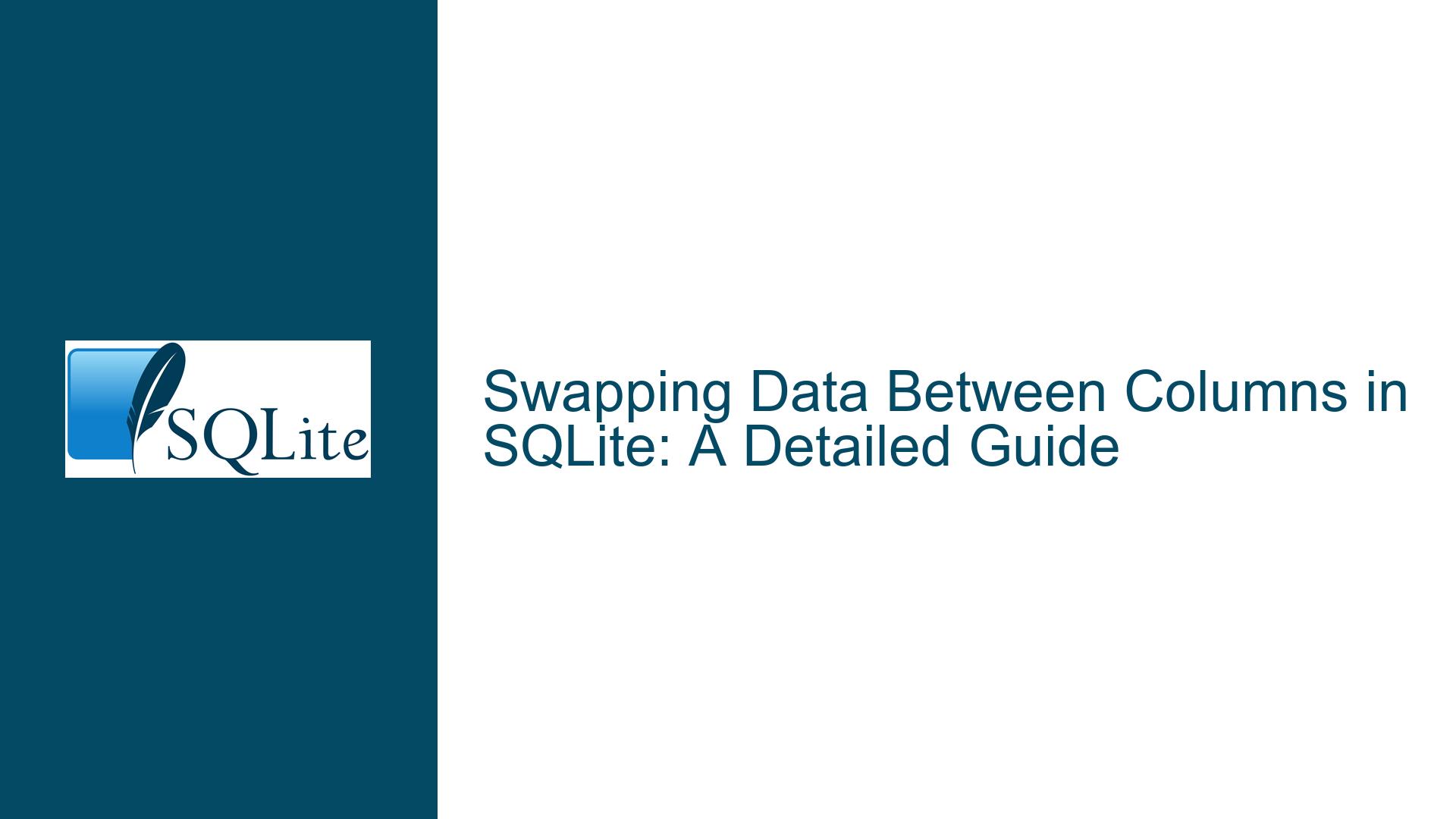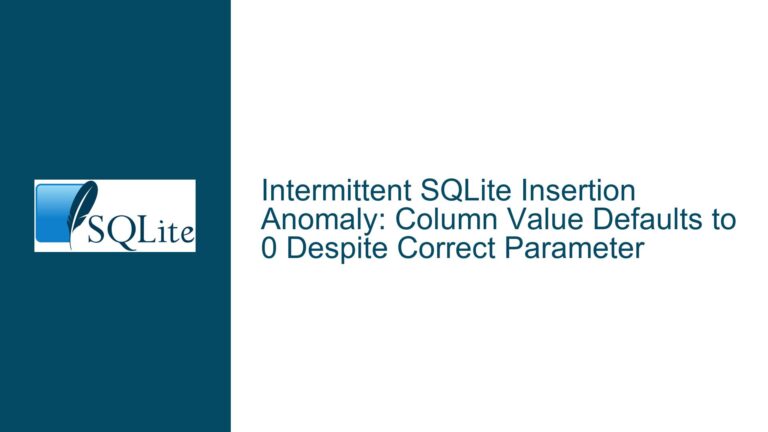Swapping Data Between Columns in SQLite: A Detailed Guide
Swapping Column Data in SQLite Without Temporary Storage
When working with SQLite databases, a common task is manipulating data within tables. One such task is swapping data between two columns. This operation might seem trivial, but it involves understanding how SQLite handles updates internally. The goal is to exchange the values of two columns, say c3 and c4, without the need for temporary storage or external scripts. This operation is particularly useful when data has been mistakenly inserted into the wrong columns, and a quick fix is required.
The table in question, t, has the following schema:
CREATE TABLE t
(
ProjID,
c1,
c2,
c3,
c4,
c5,
InsertDate,
PRIMARY KEY (ProjID,InsertDate)
);
The primary key is a composite key consisting of ProjID and InsertDate, which ensures that each row is uniquely identifiable. The columns c3 and c4 are the focus of the data swap operation.
The straightforward solution to swap the data between c3 and c4 is to use an UPDATE statement:
UPDATE t SET c3 = c4, c4 = c3;
This statement appears to assign the value of c4 to c3 and vice versa in a single operation. However, understanding why this works requires a deeper dive into how SQLite processes UPDATE statements.
How SQLite Processes UPDATE Statements Internally
SQLite does not process UPDATE statements in a left-to-right manner, where one column is updated before the other. Instead, SQLite treats the UPDATE operation as a two-step process: it first reads the old values of the row, then constructs a new row with the updated values, and finally writes the new row back to the database. This process ensures that the values being assigned are based on the original state of the row, not the intermediate state during the update.
To illustrate, consider the following pseudocode representation of how SQLite might handle the UPDATE statement internally:
struct record { ... };
record old;
record new;
while (there is more to do):
read(old);
new = old;
new.c3 = old.c4;
new.c4 = old.c3;
write(new);
In this pseudocode, old represents the original row, and new represents the updated row. The values of c3 and c4 are swapped based on the original values stored in old, and the new row is written back to the database. This approach ensures that the swap operation is atomic and does not require temporary storage.
The Role of OLD and NEW in SQLite Triggers
SQLite provides two special tables, OLD and NEW, which are accessible within triggers. These tables represent the state of the row before and after the UPDATE operation, respectively. In the context of the UPDATE statement, references on the left-hand side of the = in the SET clause refer to the NEW table, while references on the right-hand side refer to the OLD table. This distinction is crucial for understanding how SQLite ensures data consistency during updates.
For example, in the statement UPDATE t SET c3 = c4, c4 = c3;, the references to c3 and c4 on the right-hand side of the = are resolved using the OLD table, while the references on the left-hand side are resolved using the NEW table. This ensures that the values being assigned are based on the original state of the row, not the intermediate state during the update.
Comparison with REPLACE INTO
Another approach to swapping column data is to use the REPLACE INTO statement, which is syntactic sugar for INSERT OR REPLACE. This statement can be used to insert a new row or replace an existing row if a conflict occurs. However, using REPLACE INTO for swapping column data is not recommended because it can have unintended side effects, such as firing insert or delete triggers, which may not be desirable.
Consider the following example:
REPLACE INTO t (ProjID, c1, c2, c3, c4, c5, InsertDate)
SELECT ProjID, c1, c2, c4, c3, c5, InsertDate
FROM t;
This statement constructs a new row with the values of c3 and c4 swapped and replaces the existing row in the table. However, this approach has several drawbacks:
- It requires specifying all columns in the
SELECTclause, which can be error-prone. - It may fire insert or delete triggers, which can lead to unintended consequences.
- It may not work correctly if the table has foreign key constraints with
ON DELETE CASCADE.
Therefore, the UPDATE statement is the preferred method for swapping column data in SQLite.
Potential Pitfalls and Considerations When Swapping Column Data
While the UPDATE statement is a straightforward and efficient way to swap column data, there are several considerations and potential pitfalls to be aware of:
1. Impact on Indexes, Triggers, and Views
Swapping column data using an UPDATE statement can have implications for indexes, triggers, and views that depend on the affected columns. For example, if there is an index on c3 or c4, the index will be updated to reflect the new values. Similarly, if there are triggers that fire on updates to c3 or c4, those triggers will be executed. Views that reference c3 or c4 will also reflect the updated values.
It is essential to understand the dependencies on the affected columns and ensure that swapping the data does not lead to unintended side effects. For example, if a trigger modifies other columns based on the values of c3 or c4, swapping the data may lead to inconsistent results.
2. Concurrency and Locking
In a multi-user environment, swapping column data using an UPDATE statement can lead to concurrency issues. SQLite uses a locking mechanism to ensure data consistency, but it is essential to consider the impact of the UPDATE statement on other transactions that may be accessing the same rows.
For example, if another transaction is reading the values of c3 and c4 while the UPDATE statement is being executed, the other transaction may see inconsistent results. To avoid this, it is recommended to use transactions to ensure atomicity and isolation:
BEGIN TRANSACTION;
UPDATE t SET c3 = c4, c4 = c3;
COMMIT;
This ensures that the UPDATE statement is executed as a single atomic operation, and other transactions will see either the old or new values, but not an intermediate state.
3. Performance Considerations
Swapping column data using an UPDATE statement can be efficient for small to medium-sized tables. However, for large tables with millions of rows, the operation may take a significant amount of time and resources. In such cases, it is essential to consider the performance impact and optimize the operation if necessary.
One way to optimize the operation is to use a WHERE clause to limit the scope of the UPDATE statement. For example, if only a subset of rows needs to be updated, the WHERE clause can be used to filter those rows:
UPDATE t SET c3 = c4, c4 = c3
WHERE ProjID = ? AND InsertDate = ?;
This reduces the number of rows that need to be updated and improves performance.
4. Data Integrity and Constraints
Swapping column data can have implications for data integrity and constraints. For example, if there are constraints on c3 or c4, such as UNIQUE or CHECK constraints, swapping the data may violate those constraints. It is essential to ensure that the swapped data does not violate any constraints and that the operation does not lead to data corruption.
For example, if c3 has a UNIQUE constraint, swapping the values of c3 and c4 may lead to duplicate values in c3, which would violate the constraint. In such cases, it is necessary to handle the constraint violation appropriately, either by modifying the constraint or by ensuring that the swapped data does not violate the constraint.
Best Practices for Swapping Column Data in SQLite
To ensure a smooth and error-free operation when swapping column data in SQLite, follow these best practices:
1. Use Transactions
Always use transactions when performing updates that involve multiple steps or affect multiple rows. Transactions ensure atomicity and isolation, preventing other transactions from seeing intermediate states and ensuring that the operation can be rolled back in case of an error.
2. Test on a Backup
Before performing the operation on a production database, test it on a backup or a copy of the database. This allows you to verify that the operation works as expected and does not lead to unintended side effects.
3. Consider Indexes and Triggers
Be aware of any indexes, triggers, or views that depend on the affected columns. Ensure that swapping the data does not lead to inconsistent results or unintended side effects.
4. Optimize for Performance
For large tables, consider optimizing the operation by using a WHERE clause to limit the scope of the update. This reduces the number of rows that need to be updated and improves performance.
5. Ensure Data Integrity
Ensure that the swapped data does not violate any constraints or lead to data corruption. Handle constraint violations appropriately and verify that the operation maintains data integrity.
Conclusion
Swapping data between columns in SQLite is a common task that can be efficiently accomplished using an UPDATE statement. Understanding how SQLite processes UPDATE statements internally is crucial for ensuring that the operation is performed correctly and without unintended side effects. By following best practices and considering potential pitfalls, you can ensure a smooth and error-free operation that maintains data integrity and performance.






